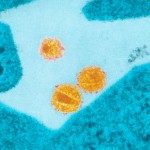Link to Pubmed [PMID] – 8203463
Am. J. Pathol. 1994 Jun;144(6):1226-37
Lymph nodes obtained from 14 macaques sacrificed at early time points following experimental inoculation with simian immunodeficiency virus were analyzed by in situ hybridization for virus load and virus cellular tropism. The lymph nodes presented a remarkably high viral load during the early phase of infection, as viral RNA was detected in as many as 2% of lymph node cells 1 week after inoculation. At this stage, macrophages and T4 lymphocytes were identified by combined immunohistochemistry and in situ hybridization as the target cells of the virus. Simian immunodeficiency virus-positive macrophages concentrated in the subcapsular sinuses, suggesting an entry of infected cells via the afferent lymphatics. A shift in the pattern of viral infection was observed at 2 weeks after inoculation, with a concentration of viral RNA in the germinal centers of the developing lymphoid follicles. Follicular dendritic cells were found to be the major target of the virus at this stage. Follicular dendritic cells were associated with high levels of viral RNA but little or no detectable viral DNA, suggesting that the virus was present mostly in the form of viral particles trapped at the cell surface. Follicular dendritic cell-associated virus persisted at high levels for 2 months before subsiding, indicating that follicular dendritic cells constituted a major reservoir of the virus during the early stages of simian immunodeficiency virus infection.
